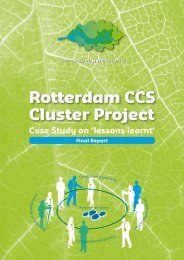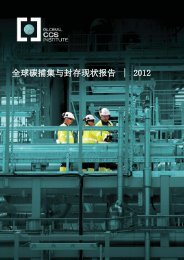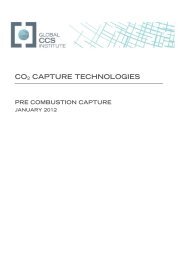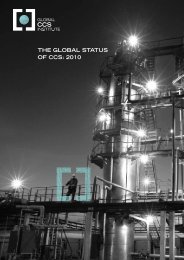Perceptions of CO2 Report - Global CCS Institute
Perceptions of CO2 Report - Global CCS Institute
Perceptions of CO2 Report - Global CCS Institute
- No tags were found...
You also want an ePaper? Increase the reach of your titles
YUMPU automatically turns print PDFs into web optimized ePapers that Google loves.
•Extra CO 2 is put in the air in greenhouses to help plants grow•CO 2 is used in some fire extinguishersInfoBProvidedInfoBProvidedInfoCProvidedInfoDInfoNyosInfoHotSpringInfoPaintfactoryInfoDomeInfoMtMammothInfoCInfoCapture 0.194 **InfoTransportInfoCauseEarthquakeInfoLiquidLikeInfoUndergroundInfoLeakSoilInfoLeakCracks -0.114 *InfoCO 2andCCInfoWhat<strong>CCS</strong> 0.073 **Lake Nyos is a crater lake in the Northwest Region <strong>of</strong>Cameroon, containing large amounts <strong>of</strong> CO 2 from volcanicactivity. In 1986 a large cloud <strong>of</strong> CO 2 was emitted suddenly andbecame trapped in the valley, suffocating 1,700 people and3,500 livestock in nearby villages.At some hot springs such as Nagayu in Japan and BadNauheim in Germany, people experience health benefits suchas good blood circulation through bathing in water with highCO 2 concentrations (about 1%).In Moenchengladbach, Germany, 107 people were injured (and13 <strong>of</strong> those were treated in hospital) when a CO 2 fireextinguisher system <strong>of</strong> a paint factory malfunctioned and CO 2was released. The nearby area was sealed <strong>of</strong>f for a time andresidents were ordered to shut their windows and go to higherfloors.For millions <strong>of</strong> years, CO 2 has been securely sealedunderground in natural underground CO 2 reservoirs. Forexample, in the USA, CO 2 fields called the Jackson, McElmo,and St. Johns Domes were formed millions <strong>of</strong> years ago, andtogether hold 2.4 billion tons <strong>of</strong> CO 2.In Mammoth Mountain, USA, a large volume <strong>of</strong> CO 2 seepingfrom volcanic activity underground has been killing nearbytrees.In industry the capture and compression <strong>of</strong> CO 2 is commonpractice. The risks associated with capturing CO 2 from theproduction process are well known and managed.The CO 2 can be transported in a gas or liquid form usingpipelines across large distances. Leaks in pipelines can occur.There is a small chance the leaked CO 2 will accumulate nearthe leakage point. The USA has a CO 2 pipeline system over3000 km long which has been in use for more than 20 years.There have been no accidents involving injuries or death.The injection <strong>of</strong> liquid-like CO 2 underground can cause microearthquakes similar to those caused by natural gas extraction.The CO 2 will enter the storage in a liquid-like form and will notreturn to a gaseous form as long as it is exposed to typicalpressure and temperature found deep underground. Here it willspread out through tiny holes in the rock formation.Underground, liquid-like CO 2 may affect microbial populationswhich are important for ecosystem stability, affect nutrientsupply, acidify ground water and affect the movement <strong>of</strong> metalsand/or other contaminants.If CO 2 leaks from the storage or injection point into thesurrounding soil, there is a small chance it might acidify topsoiland/or impact groundwater and possibly drinking water.If liquid-like CO 2 is stored appropriately, there is a very smallchance that small quantities <strong>of</strong> it would leak through poorlysealed wells, tears and cracks in the caprock layer <strong>of</strong> theunderground storage.Carbon dioxide, or CO 2, is one <strong>of</strong> the green house gases.Concentrations <strong>of</strong> CO 2 in the air are increased, which is said tobe one <strong>of</strong> the main causes <strong>of</strong> climate change. Many countries,Australia included, consider it very important to reduce CO 2emissions. One way to reduce CO 2 emissions is CO 2 captureand storage.There are three main steps to successful CO 2 capture andstorage.1) The first step is to capture and separate the CO 2 from othergases, either before or after the fuel, such as coal or naturalgas, is burned.2) The second step is to transport the captured CO 2 to a76 | Understanding how individuals perceive carbon dioxide
















